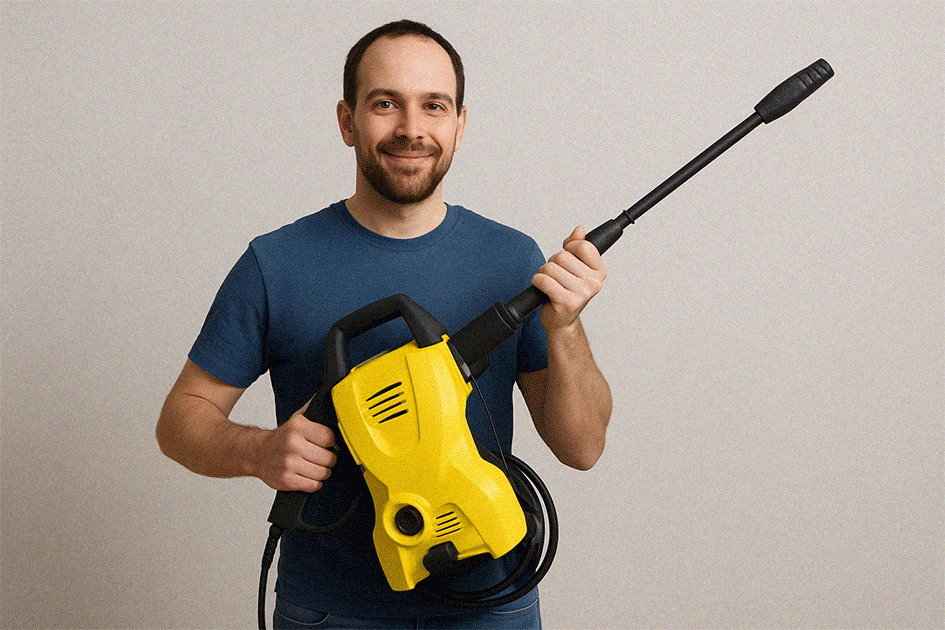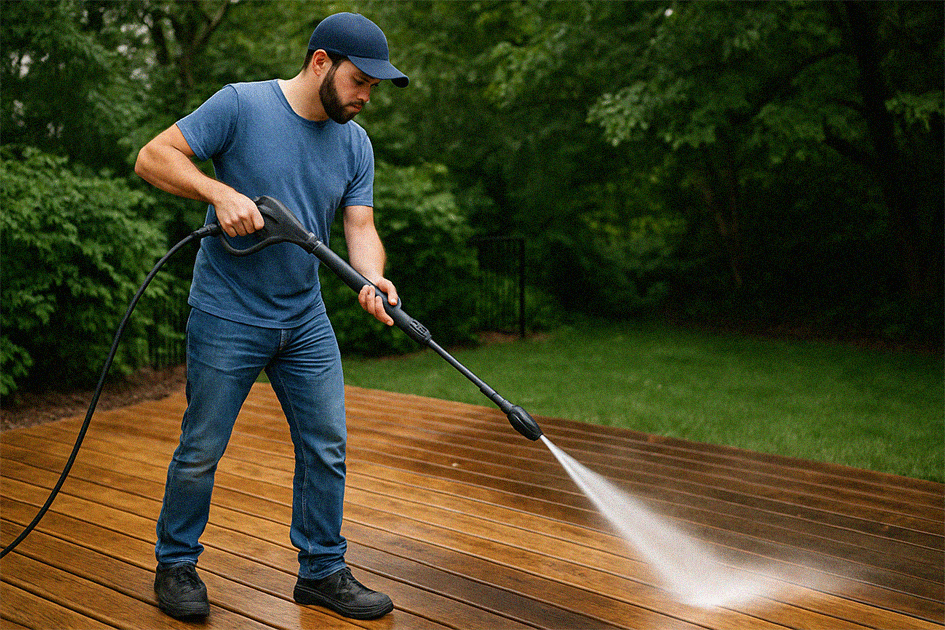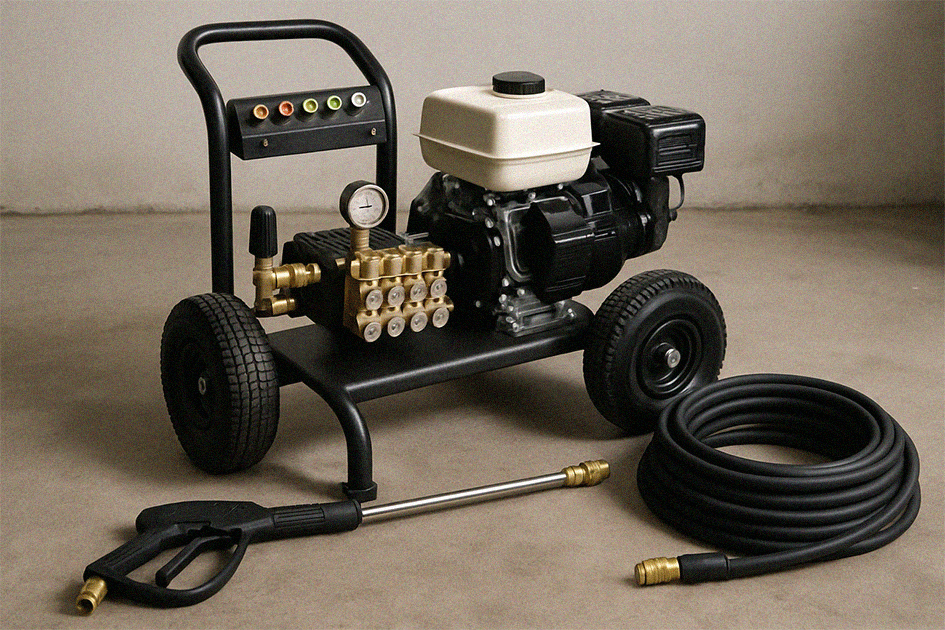
One of the most common questions homeowners ask is: "How often should I pressure wash my house?" The answer isn't one-size-fits-all—it depends on several factors including your location, climate, home materials, and surrounding environment. Let's explore everything you need to know to keep your home looking its best.
The General Rule: Once or Twice Per Year
For most homeowners, pressure washing your house once or twice a year is sufficient to maintain its appearance and protect it from damage. However, this baseline recommendation can vary significantly based on your specific situation.
At minimum, every house should be pressure washed at least once annually. This annual cleaning removes accumulated dirt, grime, and organic growth while preventing long-term staining that could permanently damage your siding. Think of it as preventive maintenance—catching problems before they become expensive repairs. Regular washing maintains your home's curb appeal and protects your investment far more cost-effectively than dealing with the consequences of neglect.
Most experts, including our team, recommend bi-annual pressure washing with strategic timing: a thorough spring cleaning in April or May removes winter grime and prepares your home for summer, while a fall cleaning in September or October clears away summer growth and prepares surfaces for winter weather. This twice-yearly approach keeps your home consistently clean rather than letting buildup accumulate for 12 months.

Factors That Affect Pressure Washing Frequency
Climate and Weather Conditions
Your local climate dramatically influences how often your home needs cleaning. Humid climates like North Carolina's create ideal conditions for mold, mildew, and algae growth—nature's way of reclaiming any surface left unattended. If you live in a region with high humidity, you'll notice green streaks and black spots appearing far more quickly than homeowners in arid climates. Plan for pressure washing 2-3 times per year if your area experiences consistently high humidity levels.
Conversely, dry climates see less organic growth but accumulate dust and airborne dirt instead. Once or twice annually is typically sufficient for these areas, though proximity to dusty roads or construction sites might warrant more frequent cleaning.
Areas with heavy rainfall present an interesting paradox. While rain rinses away some surface dirt, it simultaneously promotes moisture-related growth and splashes mud onto your home's lower sections. The constant wet-dry cycle can actually accelerate deterioration. Plan for at least twice-yearly washing in rainy regions, with spot cleaning as needed after particularly wet seasons.
Home Location and Environment
Where your home sits makes a enormous difference in cleaning frequency. Homes surrounded by trees face challenges that treeless properties never encounter: sticky sap that bonds dirt to surfaces, falling leaves and debris that decompose into staining organic matter, heavy pollen (especially from pine and oak trees), and increased shade that promotes mold and algae growth. If your home sits under a canopy or near large trees, expect to pressure wash 2-3 times per year, possibly more for heavily shaded north-facing walls.

Urban properties and homes in high-traffic areas accumulate vehicle exhaust residue, industrial pollutants, and road dust that creates a grimy film over time. Properties within a quarter-mile of busy roads should plan for at least twice-annual washing, with quarterly cleaning for homes very close to major highways or industrial areas.
Rural properties face different challenges. Red clay and dirt from agricultural activities, pollen from crops and wild vegetation, and dust from unpaved roads all contribute to faster soiling. Country homeowners should plan for twice-yearly minimum cleaning, with spot cleaning after major storms or particularly dusty seasons.
Coastal properties require the most aggressive cleaning schedule. Salt spray is corrosive and will damage exterior surfaces if allowed to accumulate. Sand creates abrasive buildup, and the combination of high humidity and salt air accelerates deterioration. If you live within a few miles of the ocean, plan for quarterly pressure washing to prevent salt damage and maintain your home's protection.
Type of Siding Material
Your home's exterior material fundamentally changes its maintenance needs. Here's what you need to know:
| Siding Material | Recommended Frequency | Maximum PSI | Special Considerations |
|---|---|---|---|
| Vinyl | 1-2 times/year | 1,300-1,600 | Shows dirt easily; prone to mold in humid climates; most common in NC |
| Brick/Stone | Once/year | 800-1,200 | Porous; harbors growth in crevices; protect mortar with lower pressure |
| Wood/Cedar | 1-2 times/year | 500-1,200 | Delicate; must seal within weeks after cleaning; avoid high pressure |
| Stucco | 1-2 times/year | 1,200-1,500 | Textured surface traps dirt; requires soft washing to prevent damage |
| Aluminum/Metal | Once/year minimum | 1,200-1,600 | Durable but shows oxidation; gentle cleaning prevents finish damage |
Vinyl siding dominates North Carolina homes due to its affordability and low maintenance. However, it shows dirt readily and develops distinctive black streaks (artillery mold spores) in humid, shaded conditions. If you have vinyl siding in areas with little sun exposure, plan for the upper end of the frequency range. The good news is that vinyl responds beautifully to pressure washing, often looking nearly new after a thorough cleaning.
Brick and stone are durable but porous, meaning they absorb moisture and harbor growth in their textured surfaces and mortar joints. Once yearly is typically sufficient, but these materials demand lower pressure settings to avoid damaging mortar. The reward for this careful approach is decades of beautiful, low-maintenance exterior walls.
Wood siding requires the most careful attention. North Carolina's humidity can be brutal on wood—one season of neglect can lead to rot, warping, or permanent staining. Never use high pressure on wood surfaces; instead, opt for soft washing techniques. Critically, you must seal your wood within 2-3 weeks after cleaning to lock out moisture and prevent the rapid deterioration that comes from exposed wood fibers.

Surrounding Landscape and Vegetation
The greenery around your home directly impacts cleaning frequency. Properties with heavy vegetation, flower beds, and gardens near the house face constant exposure to pollen, falling organic matter, and moisture from landscape irrigation. This combination creates ideal conditions for rapid dirt accumulation and growth. Pressure wash 2-3 times yearly if your home is surrounded by lush landscaping—typically spring after pollen season, mid-summer to combat growth, and fall before winter.
Homes with minimal landscaping and good air circulation enjoy a natural advantage. The lack of nearby vegetation means less organic debris, and better air flow helps surfaces dry quickly after rain, inhibiting mold and mildew growth. Annual or bi-annual cleaning is typically sufficient for these properties.
Home Age and Condition
Newer homes with modern materials and finishes often resist dirt and growth more effectively than older homes. Fresh paint, quality sealants, and contemporary siding materials create smoother, less porous surfaces where contaminants struggle to gain purchase. Annual cleaning may suffice for the first few years after construction.
Older homes tell a different story. Aging materials become more porous and damaged over time, creating perfect hiding spots for mold, mildew, and algae. Deteriorating caulk and sealant allow moisture penetration, and faded finishes lose their protective properties. If your home is more than 15-20 years old without recent exterior updates, plan for twice-yearly minimum cleaning with careful monitoring for damage signs that might require repair before pressure washing.
Signs Your House Needs Pressure Washing Now
Between regular scheduled cleanings, stay alert for these warning signs that indicate immediate attention is needed—regardless of your normal schedule.
Visible growth is the most obvious indicator. Green or black streaks running down your siding signal algae or mildew colonies establishing themselves. Dark spots or patches indicate mold taking hold, while fuzzy appearances suggest moss or lichen—organisms that can actually damage siding materials as they grow.

Staining and discoloration shouldn't be ignored. Yellow or brown streaks typically come from pollen, tree sap, or rust staining from metal fixtures. A gray or dingy overall appearance means accumulated dirt and grime have bonded to your surfaces. Uneven coloring—where some areas look significantly dirtier than others—often indicates moisture problems or drainage issues that need addressing alongside cleaning.
Declining curb appeal might seem superficial, but it matters. If your home looks noticeably dingy compared to when it was last cleaned, or if neighbors' homes appear significantly cleaner, it's time for a wash. Feeling embarrassed when guests visit is a clear sign you've waited too long.
Health concerns should never be dismissed. Family members experiencing increased allergy symptoms, musty smells near exterior walls, or visible mold on outdoor surfaces all suggest growth that could eventually affect indoor air quality. Mold and mildew don't respect the boundary between outside and inside—spores travel through windows, doors, and ventilation systems.
Pre-sale preparation is a special case. Planning to sell your home? Pressure washing can add thousands to its perceived value, help it sell faster, and create an excellent first impression that sets the tone for property showings. Schedule washing 1-2 weeks before listing or before hosting open houses to maximize impact without risking new dirt accumulation.
Your Seasonal Pressure Washing Calendar
| Season | Timing | Primary Tasks | Priority Level |
|---|---|---|---|
| Spring | March-May | Remove winter grime, clean pollen, prepare deck, main annual cleaning | HIGHEST |
| Summer | June-August | Quick pollen rinse, pre-event cleaning, light maintenance | MEDIUM |
| Fall | September-November | Remove summer growth, pre-winter prep, pre-holiday cleaning | HIGH |
| Winter | December-February | Spot clean on mild days (above 40°F), remove salt residue | LOW |
Spring represents your primary annual cleaning opportunity. After winter's assault of freezing temperatures, salt residue from ice melting, and trapped moisture, your home needs thorough attention. This is also prime time for removing spring pollen—a seemingly endless supply in North Carolina—and preparing decks for summer use. Make spring your year's main cleaning event.
Summer offers maintenance opportunities rather than deep cleaning. Quick rinses address pollen and dust accumulation, while pre-event cleaning before outdoor gatherings ensures your home looks its best. Think of summer as the light maintenance phase between your two major cleanings.
Fall's second major cleaning tackles summer's legacy: mildew from humid months, algae growth from long days of moisture and heat, and the preparation your home needs before winter weather arrives. This cleaning also readies your property for holiday guests and helps prevent winter damage by removing organic matter that could trap moisture against surfaces during freezing months.
Winter cleaning should be minimal and selective. Only clean on mild days when temperatures exceed 40°F—pressure washing in freezing conditions risks ice formation and can damage surfaces. Focus on removing de-icing salt residue that could corrode surfaces and handle light cleaning only when necessary. This isn't the season for comprehensive work.

Different Surfaces, Different Schedules
While we've focused extensively on house siding, your property includes multiple surfaces with varying maintenance needs:
| Surface Type | Frequency | Key Reasons |
|---|---|---|
| Driveways/Sidewalks | 1-2 times/year | Heavy traffic causes faster soiling; oil and tire marks need regular removal |
| Decks/Patios | 1-2 times/year + pre-sealing | Wood decks need annual cleaning to prevent decay; seal annually after cleaning |
| Fences | Once/year | Less visible but accumulates dirt/growth, especially shaded sides |
| Gutters (exterior) | 1-2 times/year | Dark streaks accumulate; clean with house washing for efficiency |
| Roofs | Every 2-3 years | Less frequent but critical for removing damaging algae and moss |
Driveways and sidewalks endure constant abuse from foot and vehicle traffic, making them high-priority surfaces for regular cleaning. Oil drips, tire marks, and ground-in dirt don't just look bad—they penetrate concrete pores and become progressively harder to remove over time. Clean these surfaces 1-2 times yearly, with additional attention for oil stains as they appear.
Decks and patios demand special attention, particularly wooden structures. Wood decks are investments that require protection through regular cleaning and sealing. Clean your deck 1-2 times per year, and always apply fresh sealer within a few weeks after cleaning. This clean-and-seal cycle is non-negotiable if you want your deck to last decades rather than deteriorating within years.
Professional vs. DIY: Making the Right Choice
The question isn't whether you can pressure wash your own home—it's whether you should. Understanding when to DIY and when to call professionals ensures the best results for your investment.
DIY Makes Sense For:
Light maintenance between professional cleanings fills an important role. Quick rinses with a garden hose remove surface pollen and dust without requiring pressure washing equipment. Spot cleaning small areas—perhaps a few feet of siding where birds have left droppings—doesn't warrant hiring pros. Cleaning deck furniture, outdoor toys, or small patio sections works perfectly as DIY projects.
Professional Service is Essential For:
Full house washing requires expertise, proper equipment, and insurance that most homeowners lack. High or hard-to-reach areas present safety risks that professionals manage daily. Delicate materials requiring soft washing techniques (wood, stucco, older brick) demand knowledge that prevents expensive damage. Heavy staining or established growth needs professional-grade cleaning solutions and application methods. And frankly, when you lack time or equipment, hiring professionals is the smart financial choice—your time has value too.
Professional advantages extend beyond just getting the job done. Pros bring commercial-grade equipment producing consistent pressure and flow that consumer models can't match. They understand how different materials respond to various cleaning solutions and pressure levels—knowledge that prevents the irreversible damage that DIY mistakes often cause. Professional services carry insurance and liability coverage protecting you if accidents occur. You save time and avoid the physical demands of hours spent pressure washing. Most importantly, you get better, longer-lasting results that justify the investment.

| Factor | DIY Approach | Professional Service |
|---|---|---|
| Cost | $100-300 (rental + supplies) | $300-600 average |
| Time Required | Full weekend (10-16 hours) | 2-4 hours |
| Quality | Variable; risk of damage | Consistent, guaranteed results |
| Insurance | Your homeowner's policy | Professional liability coverage |
| Equipment | Consumer rental, lower power | Commercial grade, optimal performance |
| Expertise | Trial and error | Years of experience |
Creating Your Personal Pressure Washing Schedule
Follow these steps to determine your ideal maintenance schedule:
First, assess your climate. Be honest about your area's humidity levels. North Carolina homeowners should automatically plan toward the higher end of frequency recommendations. Dry climate residents can safely aim for the minimum.
Second, evaluate your environment. Walk around your property and note what surrounds it. Count the trees within 30 feet. Measure distance to major roads. Check if you're near the coast. Each factor pushes you toward more frequent cleaning.
Third, check your siding material. Reference the material table above and start with that recommendation as your baseline. Note any special considerations for your specific material.
Fourth, monitor your home actively. Don't wait until problems are obvious. Set quarterly calendar reminders to walk around your property and inspect all surfaces. Early detection of growth or staining allows intervention before damage occurs.
Fifth, plan seasonally with spring and fall as your baseline cleaning schedule. Build your calendar around these two events, then add additional cleanings if your assessment suggests they're needed.
Finally, stay flexible. Adjust based on actual weather patterns, upcoming events, or visible buildup. If you notice problems developing, don't wait for your scheduled cleaning—address issues as they arise.
Cost Perspective: Investment vs. Expense
Many homeowners view regular pressure washing as an expense to minimize. This perspective is backwards. Consider these numbers:
Annual or bi-annual professional pressure washing typically costs $300-$600 per year. This investment prevents far more expensive problems:
- Premature siding replacement: $8,000-$20,000
- Deck rebuild from rot damage: $5,000-$15,000
- Major repairs from neglected maintenance: $1,000-$5,000
- Lost home value from poor curb appeal: thousands at sale time
Regular maintenance is always more affordable than major repairs. Every dollar spent on routine pressure washing potentially saves ten dollars in avoided damage. View this service as protection for your largest investment—your home—rather than optional cosmetic work.
Final Recommendations for North Carolina Homeowners
Based on our extensive experience serving North Carolina properties:
- Absolute minimum: Pressure wash once per year, preferably in spring
- Recommended standard: Twice per year (spring and fall)
- High-need situations: Quarterly cleaning (every 3 months) for coastal, heavily shaded, or urban properties
- Between scheduled cleanings: Monthly visual inspections and spot cleaning as needed
The key to success is consistency. Regular pressure washing prevents buildup from becoming embedded, protects your investment from deterioration, and keeps your home looking beautiful year-round. Established routines are easier to maintain than sporadic emergency cleaning, and the cumulative protective effect of regular washing far exceeds one-time deep cleaning followed by years of neglect.
Ready to Establish Your Pressure Washing Schedule?
At Exterior Shine, we make maintaining your home's exterior effortless with flexible scheduling options that fit your life, reminder service that helps you stay on track, package discounts for bi-annual service agreements, and same-day availability when urgent needs arise.
Don't wait until your home's exterior shows visible dirt, growth, or staining. Establish a regular pressure washing schedule today and protect your home's beauty and value for years to come. Contact us at (704) 980-9859 for your free consultation and custom maintenance schedule tailored to your specific property's needs.

Jake Deviney
Co-Founder & Operations Director
With over 15 years of experience in the exterior cleaning industry, Jake brings unparalleled expertise and dedication to every project. His commitment to using the latest equipment and techniques ensures that Exterior Shine stays at the forefront of the pressure washing industry.
